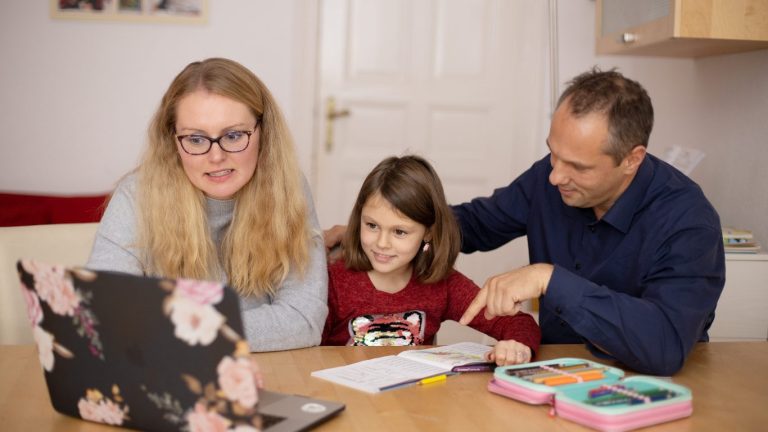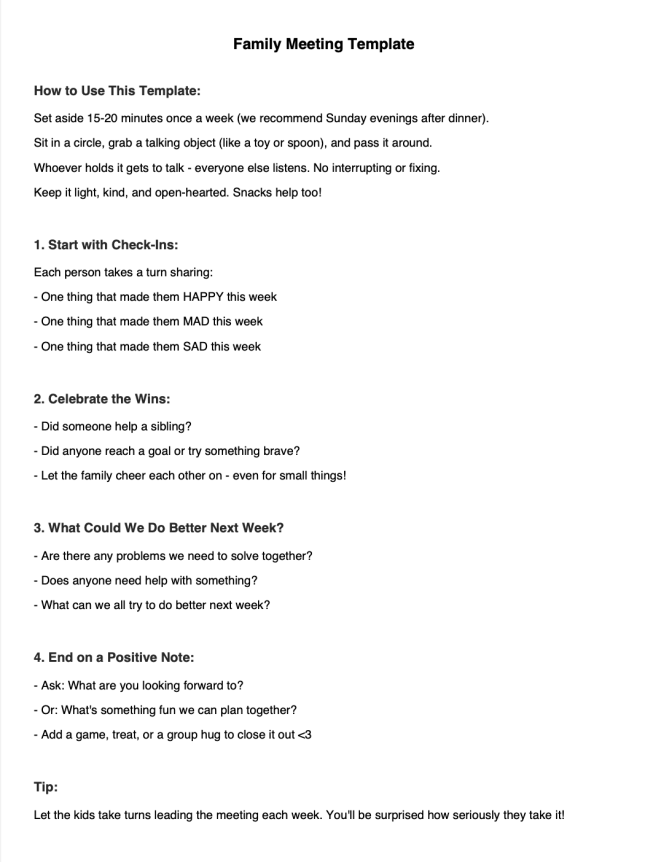It all started on a Monday morning.
The cereal was gone (again), one kid was crying because her favourite hoodie was “missing” (on the back of the couch, obviously), and I had exactly three minutes to pack two lunches, find clean socks, and figure out why someone’s shoe was wet.
I don’t even remember what set me off, but at some point I found myself standing in the kitchen — breath held, shoulders tight — and thinking, This can’t be how every week begins.
It wasn’t that we didn’t love each other. We did. Fiercely.
But between the busy schedules, the emotional rollercoasters, and the sheer noise of family life, it felt like we were constantly reacting to chaos instead of creating calm.
That was the week we tried something different.
It was awkward. A little funny.
And also… unexpectedly healing.
In this post, I want to share exactly what we did and how we did it, and why this small habit made such a big difference.
Because if you’re anything like me, you’re not looking for perfection.
Just more peace. More connection. And maybe fewer Monday meltdowns.
Let’s dive in.
The One Habit That Changed Our Family Dynamic…
Family meetings. Yes, family meetings were the one habit we were missing. Now, if you’re already imagining some overly structured, awkward sit-down with printed agendas and someone banging a gavel — pause. That’s not what this is.
When I first heard about “family meetings,” I thought, Yeah, okay, we can barely agree on what to watch on Netflix. There’s no way this will work for us.
And honestly? I was kind of right — at first.
Because the truth is, most of us parents want more connection. We want our kids to feel heard, and we’d love fewer arguments about everything from chores to who left the cap off the toothpaste (again). But in the rush of life — school drop-offs, work deadlines, dinner battles — intentional communication often slides to the bottom of the list.
That’s where a family meeting comes in. Not as a formal lecture or a “parental check-in,” but as a chance to reset. To slow down. To reconnect before the week gets wild again.
For us, it’s not about making big decisions or solving every issue.
It’s about giving everyone a safe space to speak — without interruptions, without judgment. Even the quiet ones get a turn. Even the loud ones learn to listen.
And yes, we still laugh. A lot.
Think of it like a mini tune-up for your family’s emotional engine.
Nothing fancy. Just a simple rhythm that makes everything run a little smoother.
Our Format
We didn’t invent this idea — I think I picked it up from a parenting book or maybe a podcast — but the first time we tried it, I thought, This is either going to be genius or a total disaster.
Spoiler: It was a bit of both. But mostly genius.
We called our first family meeting after dinner one Sunday night. Everyone was full, slightly suspicious, and not entirely thrilled to be sitting around the table without screens or snacks.
I kept it simple.
I said, “We’re going to try something new. Everyone gets a turn to say one thing that made them feel happy, one thing that made them mad, and one thing that made them sad this week. That’s it. No interrupting, no fixing. Just listening.”
At first, there were shrugs. Eye rolls. Someone asked if this meant they still had to load the dishwasher.
But then… my daughter went first.
She said she was happy because she made a new friend at school.
Mad because her brother took her gel pens (valid).
Sad because she didn’t get chosen for something she really wanted.
And as she spoke, something shifted. We weren’t just co-existing in the same space — we were actually hearing each other.
Her brother apologized.
I made a mental note to spend more one-on-one time with her that week.
And she left the table feeling seen.
That simple happy-mad-sad check-in became the heart of our meetings. It gives the kids (and us, if we’re honest) language for emotions we usually gloss over. It’s a soft invitation to open up, and a way to catch small frustrations before they turn into blowouts.
Sometimes the answers are hilarious. Sometimes they’re raw.
But every time, we learn something about each other we wouldn’t have known otherwise.
And that? That’s the magic.
The Surprising Benefits (That Keep Us Coming Back)
I’ll be honest — I didn’t expect much at first. I figured the novelty would wear off, or that the kids would get bored, or we’d forget to do it one week and never pick it up again.
But something surprising happened.
The more we stuck with it, the more our whole family dynamic started to shift.
Here’s what we noticed:
1. More Cooperation (With Less Nagging)
Once the kids had space to be heard — really heard — they became more open to hearing us, too. Chores got done with fewer fights. Mornings were (a little) less frantic. It wasn’t perfect, but it felt like we were finally rowing in the same direction.
2. Fewer Meltdowns and Blow-Ups
Because the little things weren’t getting buried. The “I felt left out at lunch” or “I hated when you laughed at me” stuff came out in a safe space — instead of exploding at bedtime three days later.
3. Siblings Started Looking Out for Each Other
One week, my youngest said she was sad because her big brother didn’t play with her all weekend. He looked surprised — genuinely surprised — and promised to play a game with her after dinner. And he actually did. These moments may seem small, but they build trust like bricks.
4. I Stopped Feeling Like the Emotional Middleman
Before, I was always the one trying to smooth things over — translating one child’s tears into something the other could understand. Now, they were speaking for themselves. And that took a huge weight off me.
5. It Became a Ritual We All Look Forward To
We add hot chocolate. We light a candle. Sometimes we throw in a silly “Would You Rather?” round to end on a fun note. But that consistent space — where everyone knows they’ll be heard without judgment — has become something sacred in our week.
These meetings aren’t magic. We still argue, we still forget them some weeks, and someone always ends up upside-down on the couch halfway through.
But I can say this with full confidence:
They’ve brought us closer. Helped us grow emotionally. And made our home feel more like a team — even on the cereal-crisis Mondays.
How to Start Your Own Family Meetings (Without Eye Rolls)
Okay, so maybe you’re thinking, This all sounds lovely… but my kids would laugh me out of the room.
Totally fair. I felt the same way.
But here’s the thing: kids crave structure and connection — even if they pretend they’re too cool for it. The trick is to keep it simple, low-pressure, and a little fun.
Here’s how to get started (no clipboards required):
1. Pick a Time That Works for Your Family
Sunday evenings work for us — everyone’s home, winding down, and it helps us reset before the week begins. But maybe it’s Saturday morning pancakes for you. Or a midweek dinner when life’s not too hectic. The time doesn’t matter as much as making it a habit.
2. Keep It Short (Seriously)
10–20 minutes, tops. Especially at the beginning. If it turns into a full-blown therapy session or a lecture, they’ll resist. Think of it like stretching after a workout — quick, purposeful, and part of your routine.
3. Use the ‘Happy, Mad, Sad’ Check-In
It gives everyone a starting point and keeps the focus on feelings instead of blame. For younger kids, you can even add visuals — like emoji cards or drawing their emotions if words are tricky.
Here’s is the template we use:
4. Use a Talking Object (Optional, but Fun)
Grab a random object — a plush toy, wooden spoon, glittery rock — and pass it around. Only the person holding the “talking object” can speak. It’s a silly but surprisingly effective way to encourage listening.
5. End on a Positive Note
Ask: What are you looking forward to this week? Or: What can we do to support each other more this week? Or even better: Should we bake cookies now?
A treat or a family game after helps keep the vibe light and gives everyone something to look forward to.
6. Let the Kids Lead Sometimes
Once they get the hang of it, let your child take a turn “running” the meeting. You’d be surprised how much ownership they take when they feel like it’s theirs, too.
And remember: the first few might feel awkward. Someone might mumble “IDK” to every question. Someone else might spill juice on the agenda you didn’t even need in the first place.
That’s okay.
You’re not doing it wrong — you’re just doing it real.
What to Expect in the First Few Weeks
Let me just say this upfront: your first few family meetings will probably be a little… weird.
That doesn’t mean it’s not working.
Our first one had a lot of fidgeting, one dramatic sigh, and at least two snack interruptions. At one point, someone tried to turn it into a puppet show.
Classic.
But here’s what I’ve learned: consistency beats perfection — every single time.
Here’s what to expect (and how to ride the wave):
1. Awkwardness is normal.
Your kids might be shy. Or silly. Or suspicious. (“Is this like… a trap?” one of mine asked). That’s fine. Let it be a little awkward. Lean in. You’re building something new.
2. You might get crickets.
The first time you ask, “What made you feel sad this week?” don’t be surprised if someone shrugs or says, “Nothing.” That’s okay. Keep modeling it yourself. Say your happy, mad, and sad out loud. They’re learning from you.
3. You’ll learn more than you expect.
One week, my son casually mentioned that a kid at school kept calling him “slow” during math. He said it so offhandedly — like it was no big deal. But it was a big deal. And without the meeting, I don’t think he would’ve brought it up.
4. They’ll start to look forward to it.
Give it two or three weeks, and suddenly someone will say, “Are we doing the meeting tonight?” And just like that, it becomes part of the family rhythm — like brushing teeth or arguing about screen time.
So don’t give up if it feels clunky at first.
What matters is that you’re creating a safe, reliable space. One where feelings don’t get ignored. One where everyone — including you — gets to be heard.
That alone is powerful.
Why This Matters More Than Ever
There’s a lot we can’t control as parents.
We can’t stop the world from throwing curveballs at our kids. We can’t be there to catch every heartbreak, every hard day at school, every confusing moment with a friend.
But we can create a soft place for them to land.
That’s what family meetings have become for us — a weekly pause button in the noise of everyday life. A moment to check in, connect, and say: “Hey, I see you. I hear you. You matter here.”
And if I’m being honest? It’s just as much for me as it is for them.
Because motherhood is full-on. Some days, we’re in survival mode. And yet, these 15 minutes around the table remind me that we don’t have to do it all perfectly — we just have to show up.
Especially now — in a world that moves so fast, where disconnection is often the default — these little rituals of togetherness matter more than ever.
They don’t need grand gestures.
They just need you — present, listening, and willing to try.
So if you’ve been feeling the tension, the overwhelm, or the “Why am I the only one trying to hold this family together?” energy — maybe this is your sign.
Try one meeting.
Just once.
No pressure, no perfection — just presence.
And who knows?
It might just become the one ritual your kids look back on and say, “That’s when I felt really close to my family.”







